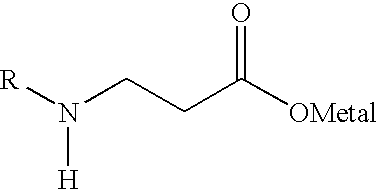Alkaline developer for radiation sensitive compositions
a technology of alkaline developer and radiation sensitive composition, which is applied in the field of alkaline developer, can solve the problems of reducing circulation flow, affecting the stability of processing equipment, and increasing the turbidity of the resulting developer, and achieves the effect of superior stability and less deposition
- Summary
- Abstract
- Description
- Claims
- Application Information
AI Technical Summary
Benefits of technology
Problems solved by technology
Method used
Image
Examples
example 1
[0079]A VSP 85 processor equipped with a 50 μm circulation filter (Glunz & Jensen) was filled with 43 1 of the following developer
[0080]
0.56 p. b. w.trishydroxymethylaminomethane 7.23 p. b. w.potassium silicate solution containing 21.5% K2O,20% SiO2 and 58.5% water 0.30 p. b. w.potassium hydroxide 88% 3.22 p. b. w.Mackam 151C ® (corresponds to (I-6c), potassiumsalt) as 40% solution in water 0.67 p. b. w.Librateric AA-30 ® (corresponds to (II-6b), monosodium salt) as 30% solution in water 0.34 p. b. w.Genapol C200 ®(corresponds to (III-8d), n = 20) 1.25 p. b. w.sodium gluconate86.41 p. b. w.deionized water
[0081]The resulting developer had a pH of 12.5 and a conductivity of 35.1 mS / cm. The operating temperature was 28.2+ / −0.2° C. Over a period of 3 days the developer was saturated with 500 m2 of non imaged N91® plates. After 50 m2 each a plate carrying different common test elements imaged with a Polaris 100® was processed and evaluated. At the same time the developer was characteriz...
example 4
[0105]A VSP 85 processor (Glunz & Jensen) was filled with 43 1 of the following developer:
[0106]
0.20 p. b. w.trishydroxymethylaminomethane 8.43 p. b. w.potassium silicate solution containing 21.5% K2O,20% SiO2 and 58.5% water 0.48 p. b. w.potassium hydroxide 88% 4.83 p. b. w.Mackam 151C ® (I-6c) as 40% solution in water 0.75 p. b. w.Luviskol K30 ® (corresponds to poly (vinylpyrrolidone)) 0.33 p. b. w.Librateric AA-30 ® (II-6b) as 30% solution in water 0.35 p. b. w.Genapol C200 ® (III-8d) 1.25 p. b. w.sodium gluconate 0.03 p. b. w.Defoamer SE 57 ® (silicon defoamer)83.35 p. b. w.deionized water
[0107]The resulting solution had a pH of 12.7 and a conductivity of 40 mS / cm. The operating temperature was 28.2+ / −0.2° C. Over a period of 3 days the developer was saturated with 500 m2 of non imaged N91® plates without any replenishment. After 50 m2 each a plate carrying different common test elements imaged with a Polaris 100® was processed and evaluated.
[0108]At the end of the test the dev...
example 5
[0110]A dip tank lab processor equipped with integrated pre heat and overcoat wash off section was filled with 8500 g of a developer containing the following ingredients:
[0111]
370.4 p. b. w.Mackam 151C ® (I-6c) as 40% solution in water 66.7 p. b. w.Librateric AA-30 ® (II-6b) as 30% solution in water350.0 p. b. w.Genapol C200 ® (III-8d) as 10% solution in water 1.94 p. b. w.Defoamer SE 57 ® 43.8 p. b. w.triethanolamine as 80% solution in water 8166 p. b. w.deionized water 37.8 p. b. w.potassium hydroxide 85%100.0 p. b. w.sodium gluconate 20.0 p. b. w.trishydroxymethylaminomethane843.4 p. b. w.potassium silicate solution containing 21.5% K2O,20% SiO2 and 58.5% water.
[0112]The resulting developer had a pH of 12.7 and a conductivity of 38.5 mS / cm. The operating temperature was 28.3+ / −0.3° C. Over a period of 2 days the developer was saturated with 100 m2 of non imaged N91® plates. After 10 m2 each a plate carrying different common test elements imaged with a Polaris 100® was processed a...
PUM
| Property | Measurement | Unit |
|---|---|---|
| pH | aaaaa | aaaaa |
| concentration | aaaaa | aaaaa |
| charge | aaaaa | aaaaa |
Abstract
Description
Claims
Application Information
 Login to View More
Login to View More - R&D
- Intellectual Property
- Life Sciences
- Materials
- Tech Scout
- Unparalleled Data Quality
- Higher Quality Content
- 60% Fewer Hallucinations
Browse by: Latest US Patents, China's latest patents, Technical Efficacy Thesaurus, Application Domain, Technology Topic, Popular Technical Reports.
© 2025 PatSnap. All rights reserved.Legal|Privacy policy|Modern Slavery Act Transparency Statement|Sitemap|About US| Contact US: help@patsnap.com



